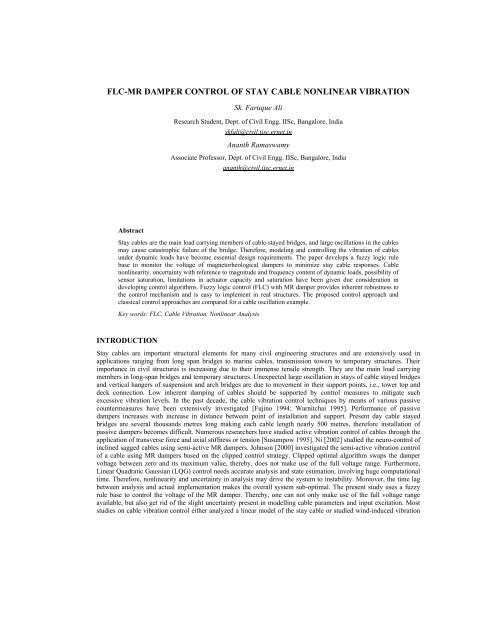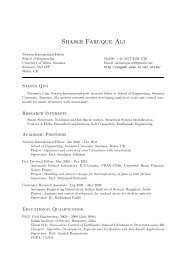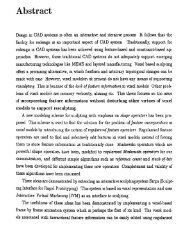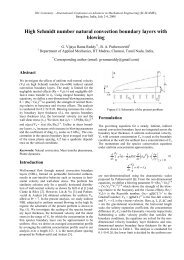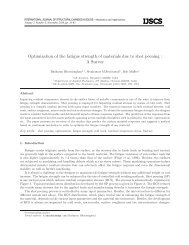flc-mr damper control of stay cable nonlinear vibration - The ...
flc-mr damper control of stay cable nonlinear vibration - The ...
flc-mr damper control of stay cable nonlinear vibration - The ...
Create successful ePaper yourself
Turn your PDF publications into a flip-book with our unique Google optimized e-Paper software.
FLC-MR DAMPER CONTROL OF STAY CABLE NONLINEAR VIBRATION<br />
Sk. Faruque Ali<br />
Research Student, Dept. <strong>of</strong> Civil Engg. IISc, Bangalore, India<br />
skfali@civil.iisc.ernet.in<br />
Ananth Ramaswamy<br />
Associate Pr<strong>of</strong>essor, Dept. <strong>of</strong> Civil Engg. IISc, Bangalore, India<br />
ananth@civil.iisc.ernet.in<br />
Abstract<br />
Stay <strong>cable</strong>s are the main load carrying members <strong>of</strong> <strong>cable</strong>-<strong>stay</strong>ed bridges, and large oscillations in the <strong>cable</strong>s<br />
may cause catastrophic failure <strong>of</strong> the bridge. <strong>The</strong>refore, modeling and <strong>control</strong>ling the <strong>vibration</strong> <strong>of</strong> <strong>cable</strong>s<br />
under dynamic loads have become essential design requirements. <strong>The</strong> paper develops a fuzzy logic rule<br />
base to monitor the voltage <strong>of</strong> magnetorheological <strong>damper</strong>s to minimize <strong>stay</strong> <strong>cable</strong> responses. Cable<br />
<strong>nonlinear</strong>ity, uncertainty with reference to magnitude and frequency content <strong>of</strong> dynamic loads, possibility <strong>of</strong><br />
sensor saturation, limitations in actuator capacity and saturation have been given due consideration in<br />
developing <strong>control</strong> algorithms. Fuzzy logic <strong>control</strong> (FLC) with MR <strong>damper</strong> provides inherent robustness to<br />
the <strong>control</strong> mechanism and is easy to implement in real structures. <strong>The</strong> proposed <strong>control</strong> approach and<br />
classical <strong>control</strong> approaches are compared for a <strong>cable</strong> oscillation example.<br />
Key words: FLC, Cable Vibration, Nonlinear Analysis<br />
INTRODUCTION<br />
Stay <strong>cable</strong>s are important structural elements for many civil engineering structures and are extensively used in<br />
applications ranging from long span bridges to marine <strong>cable</strong>s, transmission towers to temporary structures. <strong>The</strong>ir<br />
importance in civil structures is increasing due to their immense tensile strength. <strong>The</strong>y are the main load carrying<br />
members in long-span bridges and temporary structures. Unexpected large oscillation in <strong>stay</strong>s <strong>of</strong> <strong>cable</strong> <strong>stay</strong>ed bridges<br />
and vertical hangers <strong>of</strong> suspension and arch bridges are due to movement in their support points, i.e., tower top and<br />
deck connection. Low inherent damping <strong>of</strong> <strong>cable</strong>s should be supported by <strong>control</strong> measures to mitigate such<br />
excessive <strong>vibration</strong> levels. In the past decade, the <strong>cable</strong> <strong>vibration</strong> <strong>control</strong> techniques by means <strong>of</strong> various passive<br />
countermeasures have been extensively investigated [Fujino 1994; Warnitchai 1995]. Performance <strong>of</strong> passive<br />
<strong>damper</strong>s increases with increase in distance between point <strong>of</strong> installation and support. Present day <strong>cable</strong> <strong>stay</strong>ed<br />
bridges are several thousands metres long making each <strong>cable</strong> length nearly 500 metres, therefore installation <strong>of</strong><br />
passive <strong>damper</strong>s becomes difficult. Numerous researchers have studied active <strong>vibration</strong> <strong>control</strong> <strong>of</strong> <strong>cable</strong>s through the<br />
application <strong>of</strong> transverse force and axial stiffness or tension [Susumpow 1995]. Ni [2002] studied the neuro-<strong>control</strong> <strong>of</strong><br />
inclined sagged <strong>cable</strong>s using semi-active MR <strong>damper</strong>s. Johnson [2000] investigated the semi-active <strong>vibration</strong> <strong>control</strong><br />
<strong>of</strong> a <strong>cable</strong> using MR <strong>damper</strong>s based on the clipped <strong>control</strong> strategy. Clipped optimal algorithm swaps the <strong>damper</strong><br />
voltage between zero and its maximum value, thereby, does not make use <strong>of</strong> the full voltage range. Furthermore,<br />
Linear Quadratic Gaussian (LQG) <strong>control</strong> needs accurate analysis and state estimation, involving huge computational<br />
time. <strong>The</strong>refore, <strong>nonlinear</strong>ity and uncertainty in analysis may drive the system to instability. Moreover, the time lag<br />
between analysis and actual implementation makes the overall system sub-optimal. <strong>The</strong> present study uses a fuzzy<br />
rule base to <strong>control</strong> the voltage <strong>of</strong> the MR <strong>damper</strong>. <strong>The</strong>reby, one can not only make use <strong>of</strong> the full voltage range<br />
available, but also get rid <strong>of</strong> the slight uncertainty present in modelling <strong>cable</strong> parameters and input excitation. Most<br />
studies on <strong>cable</strong> <strong>vibration</strong> <strong>control</strong> either analyzed a linear model <strong>of</strong> the <strong>stay</strong> <strong>cable</strong> or studied wind-induced <strong>vibration</strong>
[Johnson 2000]. In the present study, the <strong>nonlinear</strong> response characteristics <strong>of</strong> a <strong>stay</strong> <strong>cable</strong> <strong>control</strong>led by FLC driven<br />
MR <strong>damper</strong> is analyzed based on an accurate <strong>cable</strong> model. FLC has inherent robustness under <strong>nonlinear</strong> model, and<br />
MR <strong>damper</strong>s are fail-safe, as they need only a small voltage to operate and even <strong>control</strong>s in the absence <strong>of</strong> voltage<br />
supply. Finally the paper provides a comparison <strong>of</strong> the proposed <strong>control</strong> method with other <strong>control</strong> techniques.<br />
CABLE NON-LINEAR ANALYSIS<br />
Cables remain attached to structural system like the bridge deck or supports at tower top, and experience support<br />
motion during either the movement <strong>of</strong> the deck or tower or both. <strong>The</strong>refore, <strong>cable</strong>s in <strong>cable</strong>-<strong>stay</strong>ed bridges should<br />
also be analysed to account for support motion. In this section motion <strong>of</strong> a single <strong>cable</strong> is investigated where the<br />
effects <strong>of</strong> global <strong>vibration</strong> is taken into account as motions at <strong>cable</strong> supports i.e. anchorages.<br />
Cable equation <strong>of</strong> motion<br />
Considering an uniform <strong>cable</strong> (Fig.1) <strong>of</strong> chord length ‘L’, area <strong>of</strong> cross-section ‘A’, modulus <strong>of</strong> elasticity ‘E’ and<br />
mass per unit length ‘m’, with small depth to span<br />
ratio. Thus, the static configuration <strong>of</strong> the <strong>cable</strong> can be<br />
assumed to be parabolic in the gravity plane. <strong>The</strong><br />
differential equations for the static configuration <strong>of</strong> a<br />
parabolic <strong>cable</strong> are given by [Irvine 1981]<br />
Figure 1: Typical Stay Cable With Support Motions<br />
at ‘a’ & ‘b’.<br />
directions [Irvine 1981].<br />
∂ ⎡ ∂ ⎤ ∂ u<br />
T+ u + u + X = m<br />
∂s ⎢<br />
s<br />
⎥<br />
⎣ ∂ ⎦<br />
2<br />
∂t<br />
s<br />
( τ ) ( )<br />
s<br />
v<br />
s<br />
( τ) ( ) ; ( τ) ( )<br />
2<br />
dw<br />
H<br />
dx<br />
2 s<br />
2<br />
2 2<br />
∂ ⎡ ∂ ⎤ ∂ ∂ ⎡ ∂ ⎤ ∂ w<br />
T+ v + v + Y= m T+ w + w + Z=<br />
m<br />
∂s ⎢<br />
s<br />
⎥ 2 s<br />
⎢<br />
s<br />
⎥<br />
⎣ ∂ ⎦ 2<br />
∂t<br />
∂ ⎣ ∂ ⎦ ∂t<br />
;<br />
=− mg<br />
(1)<br />
Where ‘H’ is the static horizontal tension, ‘x’ is the<br />
longitudinal coordinates <strong>of</strong> the <strong>cable</strong> system. Fig.1<br />
shows a <strong>stay</strong> <strong>cable</strong> with supports at different heights<br />
making an angle ‘θ’ with the horizontal axis. ‘u’, ‘v’,<br />
and ‘w’ are the displacements along ‘x’, ‘y’, and ‘z’<br />
axes respectively. Static and dynamic pr<strong>of</strong>ile <strong>of</strong> the<br />
<strong>cable</strong> is shown with support motions at support ‘a’ and<br />
‘b’. Superscript ‘s’ refers to the static equilibrium state.<br />
<strong>The</strong> dynamic equation <strong>of</strong> motion for the <strong>cable</strong> has been<br />
found using force equilibrium in three coordinate<br />
(2a,b,c)<br />
Where, ‘X’, ‘Y’, ‘Z’ are external forces along ‘x’, ‘y’, ‘z’ axis. Assuming that the <strong>cable</strong> deforms in the elastic range,<br />
the dynamic tension ‘τ’ can be separated from static tension ‘T’ and can be given as.<br />
s<br />
2 2 2<br />
∂u ∂w ∂w 1 ⎡⎛∂u⎞ ⎛∂v⎞ ⎛∂w⎞<br />
⎤<br />
τ(,) xt = EAε(,) xt ; ε(,)<br />
xt = + + ⎢⎜ ⎟ + ⎜ ⎟ + ⎜ ⎟ ⎥<br />
∂x ∂x ∂x 2 ⎢ ∂x ∂x ∂x<br />
⎣⎝ ⎠ ⎝ ⎠ ⎝ ⎠ ⎥⎦<br />
(3)<br />
Where ε(x,t) is the Green-Lagrange strain. <strong>The</strong> non-linear strain displacement relation makes a <strong>cable</strong> system <strong>nonlinear</strong><br />
in nature. <strong>The</strong> non-homogeneous boundary conditions arising due to support motion are;<br />
u(0,) t = u (), t v(0,) t = v (), t w(0,) t = w (). t u( L,) t = u (), t v( L,) t = v (), t w( L,) t = w (). t<br />
(4)<br />
a a a b b b
Cable Analysis with support motion<br />
To analyse the <strong>cable</strong> under support motion the total time dependent displacements are separated into two parts, quasistatic<br />
and modal motions (for details see Ali 2005). Since, longitudinal motion <strong>of</strong> <strong>cable</strong>s is less in comparison to other<br />
directions, the axial inertia force is very small and can be omitted. <strong>The</strong> axial distributed force X is assumed to be zero.<br />
After that, the modal equation with homogeneous boundary condition is solved using standard Galerkin approach.<br />
<strong>The</strong> final <strong>nonlinear</strong> differential equations <strong>of</strong> motions <strong>of</strong> <strong>stay</strong> <strong>cable</strong> are obtained as:<br />
2 2 + 1<br />
( ) ∑<br />
( )<br />
m ( y + 2 ξ y + ω<br />
2<br />
y ) + ∑v y + z y + 2β z y + 2 η ( u − u ) y + ζ v + ( − 1) n v = F<br />
(5)<br />
yn n yn n yn n nk k k n k k n n b a n n a b yn<br />
k<br />
k<br />
( ) ( )<br />
n + 1<br />
( ) <br />
2 2 2 2 2<br />
( + 2 ξ + ω ) + ∑ + + ∑2β + ∑2β<br />
+<br />
zn n zn n zn n nk k k n nk k n kn k k<br />
k k k<br />
m z z z v y z z z z y z<br />
+ 2 η ( u − u ) z + ζ w + ( − 1) w + α ( u − u ) = F<br />
n b a n n a b n b a zn<br />
<strong>The</strong> values <strong>of</strong> parameters used are given in Eq.7, where, subscript ‘n’ denotes parameters corresponding to the n th<br />
mode shape <strong>of</strong> the motion, i.e. n= 1,2,3, …,.<br />
(6)<br />
2 2 2 2 2<br />
2<br />
1<br />
2 Hπ n 2 Hπ n<br />
2λ<br />
n+<br />
1<br />
yn = zn =<br />
2<br />
; ynωyn = ; znωzn = (1 + n); n = ⎜ 4 4 ⎟( 1 + ( −1) ) ;<br />
2L 2L ⎝π<br />
n ⎠<br />
4 2 2 2 2 k + 1<br />
2 2<br />
EAπ<br />
n k ⎛EA πγn ⎞ ⎛1 + ( −1) ⎞ EA q π n mL 1<br />
= β =<br />
nk<br />
3 nk ⎜ ⎟⎜ ⎟ ηn<br />
= ς<br />
2 n = =<br />
q<br />
2<br />
8L ⎝ 4LH ⎠⎝ k ⎠ 4L nπ<br />
1+<br />
λ<br />
12<br />
2<br />
⎛ mL ⎞<br />
⎛ Eqγ<br />
L ⎞<br />
n =<br />
3 3 ⎜<br />
2 ⎟ 1 + ( −<br />
n+ 1<br />
L<br />
L<br />
2 EA ⎛γ<br />
LA ⎞<br />
1<br />
yn ∫0 n zn ∫0<br />
n<br />
⎜ ⎟<br />
H A<br />
m m mL m m k k<br />
v ; ; ; ; E E;<br />
α<br />
⎜ ⎟<br />
⎝π<br />
n ⎠ ⎜ ⎟<br />
( )<br />
⎝ ⎠<br />
( )<br />
) ; F = Yφ dx; F = Zψ dx ; λ = ; γ = mgcos( θ);<br />
H ⎝ H ⎠<br />
⎛<br />
⎞<br />
(7)<br />
Eq.s 5, 6 show that the <strong>cable</strong> dynamic equation <strong>of</strong> motion is highly <strong>nonlinear</strong> and coupled.<br />
CABLE VIBRATION CONTROL<br />
<strong>The</strong> excessive <strong>vibration</strong> in <strong>cable</strong>s under earthquake or wind induced excitations results in severe damage or even<br />
catastrophic failure <strong>of</strong> long-span bridges. <strong>The</strong>refore, <strong>cable</strong> <strong>vibration</strong> <strong>control</strong> is an important issue. <strong>The</strong> <strong>damper</strong> in a<br />
<strong>stay</strong> <strong>cable</strong> should be located within 0.05L from a support for aesthetic reasons. Optimal <strong>damper</strong> location is at 0.02L<br />
from the anchored support (Ali 2005).<br />
Passive Viscous Fluid Damper<br />
Widely used passive system for <strong>cable</strong> <strong>vibration</strong> <strong>control</strong> is the viscous fluid <strong>damper</strong>. <strong>The</strong> <strong>damper</strong> force is given by<br />
α<br />
d d d d<br />
vc<br />
f () t = C x sgn( x ).<br />
(8)<br />
Where, x is the velocity across the <strong>damper</strong> location in the <strong>cable</strong>, and C<br />
d<br />
d is an experimentally determined damping<br />
coefficient, and α, is a real positive exponent with typical values in the range <strong>of</strong> 0.35–1 for seismic applications<br />
[Agrawal 2003]. Eq. 8 represents a linear viscous <strong>damper</strong> at ‘α=1’. Nonlinear viscous <strong>damper</strong>s have become popular<br />
recently because <strong>of</strong> their <strong>nonlinear</strong> force-velocity relationships and ability to limit the peak <strong>damper</strong> forces at large<br />
velocities while providing sufficient supplemental damping. This makes the <strong>nonlinear</strong> <strong>damper</strong> efficient for near field<br />
earthquakes.<br />
Magneto-rheological Dampers<br />
When exposed to magnetic field, MR fluids change from free flowing, linear viscous Newtonian fluid to a semi-solid<br />
Bingham fluid with <strong>control</strong>lable yield strength in milliseconds. Spencer [1997] has reported both parametric and non-
parametric models for modeling MR Dampers. <strong>The</strong> most commonly used model for MR <strong>damper</strong>s is the Bouc-Wen<br />
model. <strong>The</strong> present study uses 10 volts, 50 watt MR <strong>damper</strong> with a capacity <strong>of</strong> providing 1000 kN force.<br />
f = cx +α z<br />
(9)<br />
d<br />
0<br />
<strong>The</strong> internal dynamics <strong>of</strong> the <strong>damper</strong> system is given by Eq.10. In MR <strong>damper</strong>, the <strong>damper</strong> force cannot be altered<br />
directly, therefore a clipped optimal algorithm is proposed by Dyke [1996], where, the voltage input to the <strong>cable</strong> is<br />
changed based on the <strong>control</strong> proposed by LQG <strong>control</strong>.<br />
n−1<br />
n<br />
<br />
<strong>mr</strong> a b 0 0a<br />
(10)<br />
0b<br />
z =−γ () x z z − β() x z + A (); x α = α + α u; c = c + c u ; u=−η( u−v);<br />
Fuzzy Logic Driven MR Damper Voltage<br />
<strong>The</strong> performance <strong>of</strong> clipped optimal algorithm fully depends on the accuracy <strong>of</strong> the model, as it decides the <strong>damper</strong><br />
voltage to be supplied based on the difference <strong>of</strong> LQG proposed <strong>control</strong> force and force applied by the <strong>damper</strong> at<br />
current state [Dyke 1996]. Thus not only does it increase computation but also provide <strong>control</strong> force which is not<br />
optimal to the system. <strong>The</strong> FLC has been designed using five membership functions for each <strong>of</strong> the input variable<br />
(acceleration and velocity at mid span) and four for output variable (<strong>damper</strong> voltage) for finer input-output mapping.<br />
<strong>The</strong> subsets are NL = negative large, NE = negative, ZE = zero, PO = positive, and PL = positive large, PS = positive<br />
small (Fig.2). Generalized bell-shaped membership functions have been used for the FLC. <strong>The</strong> choice <strong>of</strong> a velocity<br />
and an acceleration component for feedback can be explained in the context <strong>of</strong> the state <strong>of</strong> the system in the<br />
fundamental mode <strong>of</strong> <strong>vibration</strong>. <strong>The</strong>se feedback components help in generating the initial inference rule base (e.g., if<br />
velocity is zero and acceleration is high, the structure is at its extreme position and <strong>control</strong> action is not needed<br />
because it is going to return to its neutral position due to the restoring force, therefore voltage is zero). Again, if<br />
velocity and acceleration are <strong>of</strong> the same sign, the structure is returning to its neutral position due to its restoring<br />
force, and, if the acceleration and velocity are <strong>of</strong> opposite sign, then the structure is moving toward its extreme<br />
position and accordingly the <strong>control</strong> action should be applied. <strong>The</strong> adopted inference rules in this study are shown in<br />
Table-1.<br />
Figure 2: Input Output Membership<br />
function<br />
Velocity<br />
Table: 01 Inference Rules for FLC<br />
Acceleration<br />
NL NE ZE PO PL<br />
NL PL PO PS PS ZE<br />
NE PO PS ZE ZE ZE<br />
ZE PS ZE ZE ZE PS<br />
PO ZE ZE ZE PS PO<br />
PL ZE PS PS PO PL<br />
NUMERICAL RESULTS<br />
A test <strong>cable</strong> for analysis and <strong>control</strong> is taken from [Susumpow, 1995]. <strong>The</strong> parameters <strong>of</strong> the <strong>cable</strong> and MR <strong>damper</strong><br />
used are given in Table 2. <strong>The</strong> <strong>cable</strong> differential equations are solved using ten sine terms. Vibration analysis is<br />
carried out for El Centro Earthquake excitation at left support, right support assumed to be fixed. <strong>The</strong> <strong>damper</strong> is<br />
supposed to be located at its optimal location i.e. 0.02L [Ali, 2005] from the left support. Four types <strong>of</strong> <strong>control</strong><br />
strategies are studied, viz., passive linear viscous damping (PLVC) (case I); passive <strong>nonlinear</strong> viscous damping<br />
(PNLVC) (case II), semi active MR <strong>damper</strong> <strong>control</strong> using clipped optimal approach (COMR) (case III) and FLC<br />
driven MR <strong>damper</strong> (FLCMRD) (case IV). For the <strong>nonlinear</strong> viscous <strong>damper</strong>, test runs were done for different α vc .
Table: 02 Cable and Damper Parameters<br />
Sym Values Sym Values<br />
L 205 m C 0a 4.40 Nsec/cm<br />
A 7.2e-3 m2 C 0b 44 Nsec/(cm V)<br />
m 60.1992 n 1<br />
E 1.962e11 N/m2 A <strong>mr</strong> 1.2<br />
H 2932560 N γ 3 cm -1<br />
θ 38.7*π/180 β 3 cm -1<br />
α a 1.087e5 N/cm η 50 sec -1<br />
α b 4.961e5 N/(cmV) v 0-10 V<br />
Table: 03 Comparison <strong>of</strong> Different Control Methods<br />
Peak<br />
Disp (m)<br />
Normed<br />
Disp (m)<br />
Peak<br />
Force<br />
(N)<br />
Peak<br />
Voltage<br />
(V)<br />
Uncont 0.6752 43.7066 -- --<br />
PLVC 0.3001 27.2046 2.7e5 --<br />
PNLVC 0.3220 33.7446 2.9e5 --<br />
COMR 0.5882 28.7701 4.9e5 10<br />
FLCMR 0.3131 28.8682 2.26e5 6.7871<br />
Finally, α vc =0.6 is chosen for comparison.<br />
Viscous <strong>damper</strong> constant is taken as C d =1e6, for<br />
both linear and <strong>nonlinear</strong> case. For case III<br />
acceleration feedback is taken at the point <strong>of</strong><br />
location <strong>of</strong> <strong>damper</strong>. Kalman estimation technique<br />
is used to estimate unknown states and to <strong>control</strong><br />
the process and measurement noise. FLC is<br />
proposed based on acceleration and velocity<br />
feedback and voltage as output. For case III and<br />
IV, A/D and D/A converters with 16-bit precision<br />
and a span <strong>of</strong> ±10 volts are used. Sensor<br />
sensitivity is taken as 1V=10g and actuator<br />
capacity is assumed as 1000 kN. Sensor and<br />
actuator dynamics are not considered as natural<br />
frequencies <strong>of</strong> sensors and actuators are assumed<br />
to be much higher than the <strong>cable</strong> dominant<br />
frequency range. All four cases are compared in<br />
Table 3.<br />
Time histories <strong>of</strong> displacement at <strong>damper</strong><br />
location, normed displacement over the span at<br />
each time instance and force time history for case<br />
I and case IV are shown in Fig.3. It is evident from the figure that FLC MR <strong>damper</strong> provides similar <strong>control</strong> as<br />
PLVC, but force given to the system is less. Fig.4 shows the normed response <strong>of</strong> <strong>cable</strong> over time along the span <strong>of</strong> the<br />
<strong>cable</strong>. Fig.5 shows the voltage required for FLC based MR <strong>damper</strong> <strong>control</strong>. It is evident that FLC has achieved it goal<br />
<strong>of</strong> getting all voltages in the range <strong>of</strong> <strong>damper</strong>. <strong>The</strong>reby, providing better robustness than clipped optimal algorithm.<br />
Also the voltage never reaches its maximum<br />
thereby, avoids actuator saturation.<br />
Figure 3: Time Histories<br />
Figure 4: Normed response along span<br />
Stability <strong>of</strong> proposed FLC based MR <strong>damper</strong> <strong>control</strong> is shown by taking worst-case initial condition, where both<br />
velocity and acceleration are given its maximum values. Fig.7 shows how the time histories <strong>of</strong> velocity and<br />
acceleration.
Figure 5: Voltage Time history<br />
CONCLUSION<br />
Figure 6: Velocity and Acceleration Time<br />
history<br />
From the <strong>vibration</strong> analysis and FLC based <strong>control</strong> <strong>of</strong> the <strong>stay</strong> <strong>cable</strong> the following conclusions may be reached:<br />
1. Passive <strong>damper</strong>s located on the <strong>cable</strong> are quite effective in limiting the <strong>vibration</strong> amplitudes. But increase in<br />
length <strong>of</strong> <strong>cable</strong> reduces their performance as the optimal location (0.02L) <strong>of</strong> the <strong>damper</strong> placement becomes<br />
inaccessible.<br />
2. FLC based voltage switching <strong>of</strong> MR <strong>damper</strong> voltage provides better <strong>control</strong> than clipped optimal <strong>control</strong> as it<br />
varies the voltage over the full range.<br />
3. FLC along with MR <strong>damper</strong> provides inherent robustness to the system.<br />
4. Semi active MR <strong>damper</strong>s are not effective when deployed individually but may <strong>of</strong>fer an attractive alternative to<br />
active systems when used along with passive systems as a hybrid system.<br />
REFERENCES<br />
Agrawal A. K., Yang J. N., and He W. L., “Application <strong>of</strong> Semiactive Control Systems to Benchmark Cable-Stayed<br />
Bridge”, Jr. <strong>of</strong> Struct. Engg., ASCE, Vol.-129 (7), 2003, Pp-884-894.<br />
Ali, Sk. F. and Ramaswamy, A., “Nonlinear Modelling and Control <strong>of</strong> Cable in Cable Stay System using Passive and<br />
Semi Active Means”, Proc. <strong>of</strong> Structural Engineering Convention, Dec-14-16, 2005.<br />
Dyke, S. J., Spencer. B., F., Jr, Sain, M., K., and Carlson, J. D., “Modeling and Control <strong>of</strong> Magnetorheological<br />
Dampers for Seismic Response Reduction.” Smart Mater. Struct, Vol. 5. 1996, pp 565–575.<br />
Fujino, Y. and Susumpow, T, “An Experimental Study on Active Control <strong>of</strong> in Plane Cable Vibration by Axial<br />
Support Motion.”, Earthquake Engineering and Structural Dynamics 23, 1994, 1283-1297.<br />
Irvine, H., M., Cable Structures., Cambridge, Massachusetts MIT Press. 1981<br />
Johnson E.A., Baker G.A., Spencer Jr. B.F. and Fujino Y., “Mitigating Stay Cable Oscillation Using Semiactive<br />
Damping.” Smart Structures and Materials 2000: Smart Systems for Bridges, Structures, and Highways, S.C. Liu<br />
(ed.), SPIE Vol. 3988, 2000, pp 207-216.<br />
Ni Y.Q., Chen Y., Ko J.M., and Cao D.Q., “Neuro-Control <strong>of</strong> Cable Vibration Using Semi-Active<br />
Magnetorheological Dampers.” Engineering Structures., Vol. 24, 2002, pp 295-307.<br />
Spencer, B. F., Jr, Dyke, S. J., Sain, M. K., and Carlson, J. D., “Phenomenological Model <strong>of</strong> a Magnetorheological<br />
Damper.” J. Eng. Mech. ASCE. Vol. 123, No. 3, 1997, pp 230–238.<br />
Susumpow, T., and Fujino, Y. “Active Control <strong>of</strong> Multimode Cable Vibration by Axial Support Motion.”, Jr. <strong>of</strong><br />
Engg. Mech. ASCE. Vol.121, No. 9, 1995, pp 964-972.<br />
Warnitchhai, P., Fujino, Y., and Susumpow, T., “A Non-linear Dynamic Model for Cables and its Application to a<br />
Cable-Structure System.” Jr. <strong>of</strong> Sound and Vibration, Vol 187, No. 4, 1995, pp 695-712.


